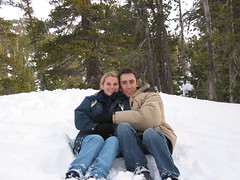BFJ
We spent today touring around the Plain of Jars. They are actually several hilltops around Phonsavan with large, stone jars scattered about. There are a few theories as to why/how these jars were constructed, but no one knows for sure. Since there has not been any organic matter found among the jars to date them, archaeologists can only guess as to how old they are, around 2000 years. There are 15 sites of jars, and we visited 3 of them. Overall, there are hundreds of them, and could be even more as they are still uncovering some.
Theory 1: The jars were used to ferment rice wine to celebrate the war victory of the 6th century Lao-Thai army over the evil Chao Angka.
Theory 2: The jars were used to put the dead in, where the flesh decomposed, then the bones were removed and buried in a second location.
Theory 3: The jars were used to ferment rice wine for the entire village to celebrate the completion of the army's training, ready for their next battle.
Of course there are many more, but there is no proof to legitimise any of them. Some people believe the jars were made from a mixture of buffalo skin, sandstone, limestone and a local plant. Others believe they were carved from a single boulder. No two jars are the same. Some are bigger than us (the largest is about 2.5 metres high), most are at least as large as a wine barrel. Most have round openings, but some have square or rectangular openings & shapes. Many of them have been destroyed by weather, bullets, and bombs. This area was perhaps the most heavily bombed area during the entire Vietnam war. Evidence of this is still extremely vivid, as we had to follow a very narrow trail where UXO have been cleared. A team of people, called the MAG (Mine Advisory Group) work 5 days a week to clear mines in this area. Only 3 weeks ago, they found a large cluster bomb among the jars at site 3 that could not be removed, so they had to explode it. It was quite scary thinking about it, and knowing there are hundreds more. They even find more UXO in previously cleared areas, overlooked due to the high concentration of them.
It was great to walk around the countryside to see such ancient artefacts (we think we enjoy seeing the really old stuff the best). It adds to the mystery of the jars that it is still unclear what they were for or who built them or how old they are. We enjoyed imagining the people who built them and thinking of them partying, drunk on their vast amounts of rice wine. Kel's theory is that they were used simply to collect & store rain water. Nige likes the rice wine theory.
After returning to the hotel, we had a few beers and watched a video on the CIA operative in the area during the Vietnam War. They built a secret town in the mountains just south of Phonsavan (now called the Special Zone) where US Air Force pilots lived as civilians to go on scouting and bombing runs over the Ho Chi Minh trail, the Plain of Jars area (Vietcong soldiers would hide in the jars), and other areas. It was against the Geneva Convention to have any military personnel in Laos (Laos was a neutral zone during the war), so all of this was secret. The bombers were called The Ravens. Today there are still pockets of Hmong minority guerillas (who fought with the US) fighting against the Laos Communist government, and some areas are considered rebel territory.
We had dinner at the hotel again and had an early night to bed.


0 Comments:
Post a Comment
<< Home